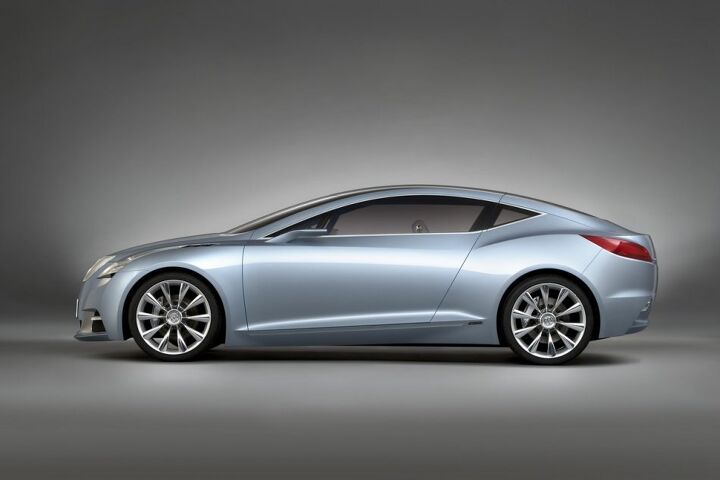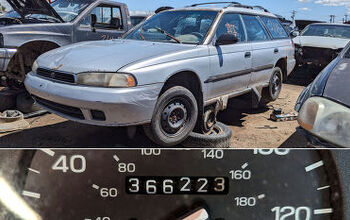19 Views
Editorial: GM Deathwatch 229: Opel For Opel's Sake
by
Edward Niedermeyer
(IC: employee)
Published: January 29th, 2009
Share
Motorauthority reports that the long-rumored Buick C-segment sedan will probably be built at Opel’s Rüsselsheim plant. The new, entry-level Buick will utilize production capacity freed by plans to produce the Delta II-based Saab 9-3 at Saab’s Trollhättan plant. Since the American Astra experiment has gone so badly, GM needs a higher-margin Delta II vehicle to justify expensive tooling efforts at Rüsselsheim. Hence the plan for a Buick compact for the U.S. market. It’s a deeply misguided project, yet another sign of GM’s chronic, ongoing, multi-national mismanagement of its models, brands and [dwindling] resources. What is it with these people?With the future of Saturn and Saab up in the air, with the HUMMER brand on death row, GM is trying to chart a course to “viability” based on constantly-changing assumptions. One of those: Buick should be a “core brand.” God knows where GM got that idea. Buick is one of the two rotting limbs on the corpse currently known as the Buick, Pontiac and GMC (BPG) “channel.” Buick hasn’t had a hit product since… wait… I’m thinking. The Lambda-based Buick Enclave was supposed to be one of GM’s Next Big Things. The CUV never found its stride. A year ago, TTAC’s Frank Williams wrote Buick sales suck. A s you can imagine, they went downhill from there. At the time, Williams wondered if GM was trying to starve Buick to death. Perhaps they were. And changed their mind. Several times. Anyone familiar with GM’s on-again, off-again, we don’t know yet (a.k.a. “strategic review”) product plans knows that indecision and paralysis is GM’s leitmotif. GM’s new plan: between now and 2012, Buick will offer Americans a thin diet of me-too rebrand jobs: the new LaCrosse, this Delta II whatever and a Lambda CUV (Enclave). Needless to say, these examples of cost-cutting platform-sharing badge engineering will continue to debase whatever appeal the Buick brand once held for its loyal customer base. Or anyone else.And yet, Buick somehow remains one of GM’s four “core brands.” There’s only one remotely plausible explanation: Buick’s success in China has convinced RenCen that the brand has a future. Of course, Buick doesn’t mean anything in particular in China. So why should it mean anything stateside? That would explain the plan to build a compact Buick for the U.S. market. The funny thing is it just might work. By now, nobody anywhere expects a Buick to be anything more than an up-optioned Chevy.Even if we accept the fantastic possibility that when better Buicks are built someone will buy them, the real problem is building them in Germany. First, there’s an issue of cost. Thanks to higher labor costs, building in the Eurozone is an expensive business. And then there’s the fact that GM doesn’t sell Buicks in Europe. The cost of shipping vehicles to the US (China?) will hurt both profitability and sales. And don’t forget about the currency issue. If the Pontiac G8 and Saturn Astra experiences taught GM anything, there’s no way this idea will work. Then there’s the branding opportunity cost. Understandably enough, Opel’s bosses feel that branding GM’s best products as weaker marques hurts GM as a whole. “Only under the Opel brand can Opel products profit from their heritage, as it lends the ‘German Engineering’ appeal,” Opel boss Klaus Franz tells Handelsblatt.Indeed, GM has sunk considerable amounts of cash into Opel in hopes of bringing the brand upmarket. It appears to be working. So why hide this success behind a brand that (outside of China) represents a tarted-up Chevy?Why bother? In the U.S. and elsewhere, Opels could be sold as Opels, replacing GM’s confused mid-market branding “strategy.” With Chevy (Korean budget), Opel (German engineered, efficient, tech-y mid-level) and Cadillac (American luxury) GM can cut its portfolio to three complimentary global brands.Pontiac, Saab, Saturn and Buick have to go. The fact that each of these four brand fiefdoms are fighting for Opel underpinnings for their products says everything. At this point, what does GM have to gain by holding onto the past with these useless antibrands? Opel can (and does) do everything these four brands do, only with a glint of European luster. Introducing the Opel brand in the US would have its risks. But at least it’s a fresh start. Selling its superior products under its real name helps GM considerably more than hiding them under the sheetmetal of a dead brand walking.This strategy is similar to the approach that Ford is taking by bringing the Euro-spec Fiesta, Focus, C-Max and Kuga stateside. Ford’s job just happens to be easier, thanks to being called “Ford” in Europe. Like Ford’s plan, an Opel revamp of GM’s mid-market vehicles would have to involve local production to avoid Astra/G8 redux. And it wouldn’t be easy with the General’s current cash position. But at least it would be a “viable” strategy.
Edward Niedermeyer
More by Edward Niedermeyer
Published January 29th, 2009 2:26 PM
Latest Car Reviews
Read moreLatest Product Reviews
Read moreRecent Comments
- Theflyersfan I'm having a tough time figuring out Mazda's recent lineup decisions. I've mentioned before how having the CX-5 and CX-50 makes no sense as it seems like they would steal each other's sales instead of conquest sales from other brands. And now here comes the CX-70 vs 90 decision. If Mazda wanted to position the 70 above the 90 with pricing, I think they should have gone the Audi Q7 vs Q8 route. The Q8 costs more, has one fewer row, and is smaller on the inside, but has the more aggressive styling and tries to position itself as the sportier alternative large CUV in their lineup. With Mazda, the 70 and 90 seem to be in the position, like the 5 vs 50, to steal each other's sales. There isn't anything compelling me to get a 70 if I get more for my money with a 90, except 100,000 miles down the road, I won't have a folded up third row seat rattling around loosely. Mazda should have brought over the CX-60 and position that where they wanted the 70. I understand it's a touch larger than the X3, Q5, and GLC CUVs, which is a sweet spot in that market. Make the CX-70 a sportier alternative 2-row instead of such a blatant cynical move of just ripping a seat out of the 90, calling it an all new model and price it in the same ballpark. I want Mazda to succeed and continue to be independent, but decisions like these make me wonder what their future plans are.
- Daniel J This thing is just too big and not packaged great being RWD. I'd prefer a FWD/AWD pre 2024 Santa Fe sized vehicle. A true CX-70.
- Ash78 Now that we're on the topic, I think Apple owes us all a ton of money for bringing out new phones every 1-2 years and devaluing the one I have! /sDepreciation has always been a part of car ownership, far more so now if you're getting into EVs. I think it's just the discrete nature of these depreciation events (ie, price cuts) that have everyone wringing their hands.I'm too price sensitive -- not necessarily to BUY an EV -- but for the fear of what a truly disruptive battery tech might do to them. Split the differene with a hybrid or PHEV and you've reduced your car's reliance on battery tech as the primary determinant of value.
- Ash78 Interesting take on the pricing...superficially illogical, but Honda has been able to sell the Pilot Junior (er, Passport) for more than the Pilot for several years now. I guess this is the new norm. I have 2 kids, who often have friends, and I feel like the best option here is buying the CX-90 and removing the third row completely. It won't be pretty, but it adds useful space. We've done that in our minivan several times.I've been anxiously awaiting the 70 for over a year, but the pricing makes it a non-starter for me. I like the 50, but it's tight (small, not dope/fire/legit); I like the 90s, but it's more than we need. This "Goldilocks Solution" feels like it's missing the mark a little. Mazda could have gone with more of a CX-60 (ROW model) and just refreshed it for the US, but I suspect the 90 was selling so well, the more economical choice was just to make it the same basic car. Seems lazy to me.
- FreedMike If you haven't tried out the CX-90, do so - it's a great driver, particularly with the PHEV powertrain.


































Comments
Join the conversation
If GM is to revive Buick, it needs to remember what a Buick is. That concept car isn't a Buick, at least not after a gigantic slab of granite dropped on the roof. You'd think GM would check out an Avalon. There are a lot of people holding onto their LeSabres and Park Avenues because they can't buy a traditional Buick. Yeah, their hair is thin, but their wallets are thick.